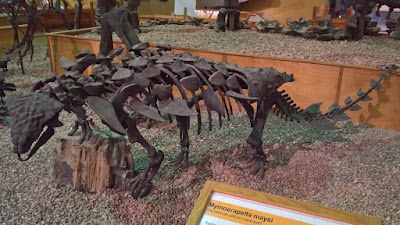Dracopelta zbyszewskii, the Portuguese Dragon Knight
I feel that even though the blog is named Dracopelta, there was no proper explanation or introduction as to why I chose this name. So, this post is exactly about this enigmatic taxon and the namesake of the blog.
Dracopelta zbyszewskii is a poorly known taxon of ankylosaur from the Late Jurassic of Portugal. It was named in 1980 by Peter Galton and its genus name comes from the Latin “draco” for dragon and from the Greek “peltē” for small shield. The exact positioning of D. zbyszewskii within Ankylosauria is problematic, with authors considering it either an nodosaurid (Galton, 1980, 1983; Coombs & Maryańska, 1990), a polacanthid incertae sedis (Pereda-Superbiola et al., 2005, and reference therein), Ankylosauria incertae sedis (Pereda-Superbiola et al., 2005) or even nomen dubium (Carpenter, 2001).
Dracopelta zbyszewskii is a poorly known taxon of ankylosaur from the Late Jurassic of Portugal. It was named in 1980 by Peter Galton and its genus name comes from the Latin “draco” for dragon and from the Greek “peltē” for small shield. The exact positioning of D. zbyszewskii within Ankylosauria is problematic, with authors considering it either an nodosaurid (Galton, 1980, 1983; Coombs & Maryańska, 1990), a polacanthid incertae sedis (Pereda-Superbiola et al., 2005, and reference therein), Ankylosauria incertae sedis (Pereda-Superbiola et al., 2005) or even nomen dubium (Carpenter, 2001).
It
was discovered in the 60’s during the construction of a road near the coastal
village of Ribamar, in the municipality of Torres Vedras, Portugal. Georges
Zbyszewski, a prominent French geologist and paleontologist who worked for
decades in the Geological Services of Portugal and in honor of whom the species
was named, was responsible for the excavation and preparation of the specimen
in Lisbon (Pereda-Superbiola et al.,
2005). Only in 1980 was the specimen described for the first time, by Peter
Galton (Galton 1980). At the time, the author identified the type locality only
as Ribamar. However, there are two localities with this name in Western Portugal,
about 25 km from each other: Ribamar, in Lourinhã, and Ribamar, in Ericeira (Pereda-Superbiola
et al., 2005, Fig. 1 therein). For 25
years, the type locality was the former. In 2005, Pereda-Superbiola and
colleagues readdressed the issue by describing additional holotype material, articulated
autopodial remains, and identifying the type locality as Ribamar from Ericeira,
more to the South than previously thought.
The holotype (Fig. 1) is a
partial ribcage with 13 dorsal vertebrae and five different types of dermal
armor (Galton, 1980) and an incomplete autopodium with three metapodials and
digits II, III and IV (Pereda-Superbiola et al., 2005). Based on the anatomy of the
vertebrae and ribs, the presence of different types of dermal plates, consisting
of very small isolated flat scutes, small medial paired circular plates with
raised centers and rims, very long anterolateral plates, narrow nonprojecting
overlapping dorsolateral plates and overlapping laterally projecting lateral
plates, and ossified tendons, and later with the additional autopodium
material, D. zbyszewskii was ascribed
to Ankylosauria incertae sedis (Pereda-Superbiola et al., 2005). Additional material is
needed to properly assess the validity of the taxon and its exact phylogenetic
position.
One
of the most fascinating aspects of D. zbyszewskii
is its age. It comes from the Late Jurassic of Portugal, close to the top of
the Lourinhã formation. The Lourinhã formation is a continental fluvial
depositional sequence of Late Kimmeridgian to latest Tithonian-earliest
Berriasian? in age. Therefore, the occurrence of this taxon is particularly
relevant since for the Late Jurassic there are three known ankylosaur taxa, Mymoorapelta maysi Kirkland &
Carpenter 1994 and Gargoyleosaurus
parkinorum Carpenter, Miles & Cloward 1998, from the Upper Jurassic
Morrison Formation, in the USA, and D.
zbyszewskii being the third. The relationships between these taxa and other
basal members of the Ankylosauria may provide a valuable insight into the origin
and evolution of the group as well as a clarification of the systematic
position of D. zbyszewskii and “polacanthid”
(sensu latum) ankylosaurs.
My research aims to clarify these points and bring D. zbyszewskii and its basal counterparts to a new light while establishing a proper, more in depth take on the phylogeny of the basal members of the Ankylosauridae and understanding the timing of the split between different groups within Ankylosauria and the evolution of the group.
My research aims to clarify these points and bring D. zbyszewskii and its basal counterparts to a new light while establishing a proper, more in depth take on the phylogeny of the basal members of the Ankylosauridae and understanding the timing of the split between different groups within Ankylosauria and the evolution of the group.
Carpenter, K., Miles, C.,
and K. Cloward. 1998. Skull of a Jurassic ankylosaur (Dinosauria). Nature, 393:
782-783.
Carpenter,
K. 2001. Phylogenetic analysis of the Ankylosauria; 455-483 in K. Carpenter (Ed.),
The Armored Dinosaurs; Indiana University Press, Bloomington &
Indianapolis, USA.
Coombs,
W. P., and T. Maryańska.
1990. Ankylosauria; 456-483 in D. B. Weishampel, P. Dodson, and H. Osmólska (Eds.),
The Dinosauria, University of California Press, Berkeley, USA.
Galton,
P. M. 1980. Partial skeleton of Dracopelta
zbyszewskii n. gen. and n. sp., an ankylosaurian dinosaur from the Upper Jurassic
of Portugal. Geobios 13: 825-837.
Galton,
P. M. 1983. Armored dinosaurs (Ornitischia: Ankylosauria) from the Middle and
Upper Jurassic of Europe. Palaeontographica A, 182: 1-25.
Kirkland, J. I., and K. Carpenter.
1994. North America's first pre-Cretaceous ankylosaur (Dinosauria) from the
Upper Jurassic Morrison Formation of Western Colorado. Brigham Young University
Geology Studies, 40: 25-42.
Pereda-Superbiola,
X., Dantas, P., Galton, P. M., and J. L. Sanz. 2005. Autopodium of the holotype of Dracopelta zbyszewskii (Dinosauria, Ankylosauria) and its type
horizon and locality (Upper Jurassic: Tithonian, western Portugal). Neues Jahrbuch für Geologie und
Paläontologie-Abhandlungen, 235(2): 175-196.


Comments
Post a Comment